I have seen this question asked on a Facebook group, and from the discussions that followed I realized it may be good to have an article that provides a thorough answer. So, here it is, keep reading.
If you want a quick answer, no, it is not possible to walk Alta Via 1 route by camping legally. There are a few camps that are reasonably close to the AV1 route, but they are too few and too far apart. There is no way you can get to them from any side within one day, or to walk between them in one day.
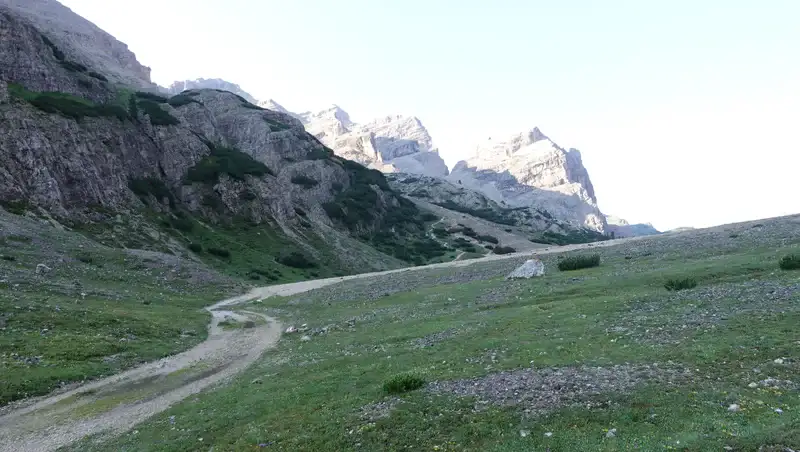
The Alta Via 1 route map
The AV1 route is around 125 kilometers long. But you will realize from the picture below that it has two ways to end it up (assuming that you start from the north), or to start it (if you start from the south).
There are also various variants along the route, and you can make your own variants dependent on your own preferences.
All in all, the total length number may vary from one source to another. But this is a relatively long trip for the Alps standards, and it needs multiple days to be completed. How many? I would say 6-12 days most of the time dependent on your physical condition and stamina.
Here is the Alta Via 1 map showing the start at Lago Braies (marker 1) and two possible ends (markers 2 and 3):
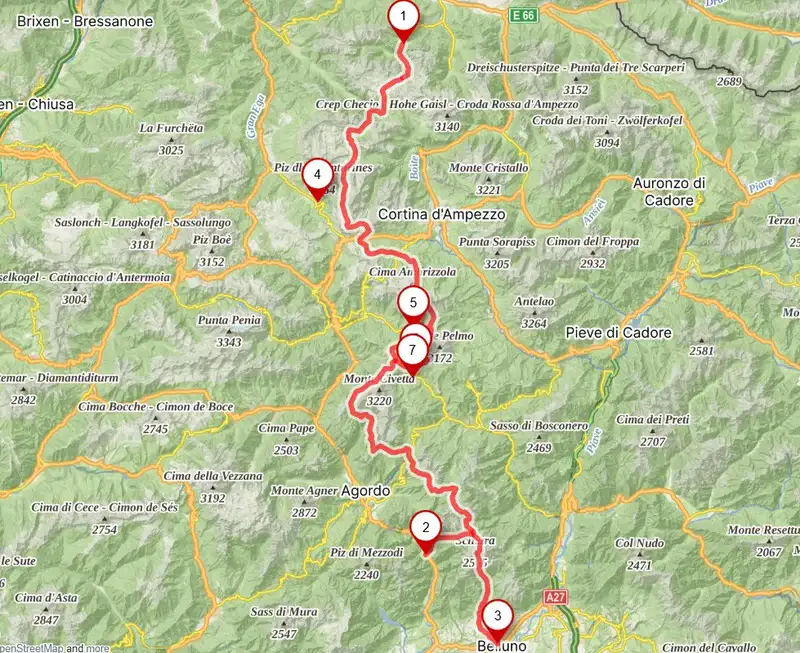
The map includes also the following:
- Camping Sass Dlacia (marker 4).
- Camping Cadore (marking 5).
- Camping Palafavera (marking 6).
- Camping Civetta (marking 7).
You can install an app on your smartphone and have access to all the camping places in the area, and also to 23000 other campsites in 44 European countries.
Below are the details of the three camping places that are too close to each other to have any practical value. By this, I mean that you can use one of them, but the other two are then useless. It is the same as if you would have only one in that particular area.
Observe also two popular variants of walking the route in that area (if you would use huts), but you can have them as many as you want.
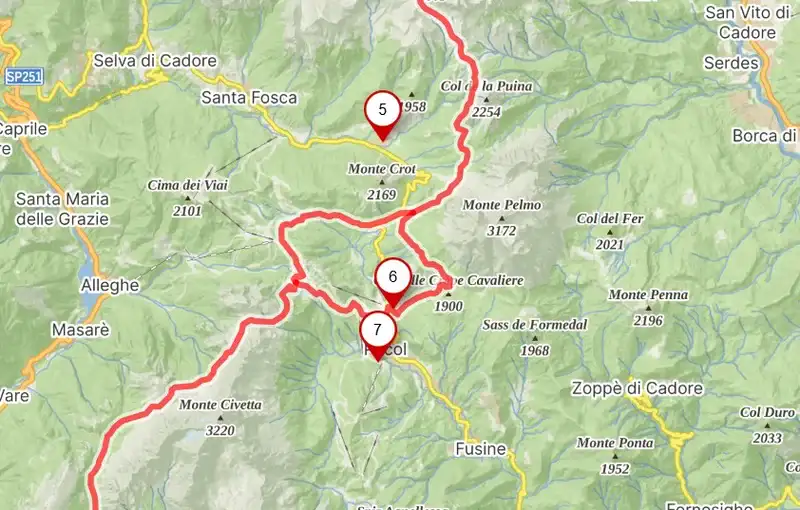
Now, what can you read from the maps?
The only way to do the route legally by camping in official camp spots is to do it in three sections/stages:
- Stage 1 – 4.
- Stage 4 – 5,6,7.
- Stage 5,6,7 – 2.
Here, the numbers correspond to the camp spots in the maps. What you may not realize from the picture is the following: the straight line map distance of each of the mentioned stages is more than 20 kilometers.
In reality, on the ground you will have to walk twice that length, remember that the actual route length is more than 120 kilometers. In other words, think about 40 kilometers daily for the three stages mentioned above. In fact, the last stage is much longer that the other two.
But it is not only about physical ground length, this includes lots of ups and downs. How much of it? Here it is from my another article:
- Total altitude gain on ascent: about 7300 m.
- Total altitude on descent: about 8400 m.
- Maximum altitude: Lagazuoi hut, 2752 m.
Remember also that this is about camping (in official camp spots), so you are supposed to carry everything for sleeping in a tent. This would include at least the following:
- A backpacking tent.
- A sleeping pad.
- A sleeping bag.
Then you will need a backpacking pillow, things for outdoor cooking like a gas stove, some pot, and other stuff.
In addition, as you realize all these camp spots and bivouacs are off the AV1 route, so make sure that you have good maps with you. You need 1:25000 ratio type, and you can find them here.
So, what do you think, can you do it? If yes, you are a superhuman.
Anything else to help the journey?
Actually, there is. You will realize this from the maps below. As you realize, I have added one marker in the stage 1 area, the marker 8, which is the position of Bivacco della Pace:
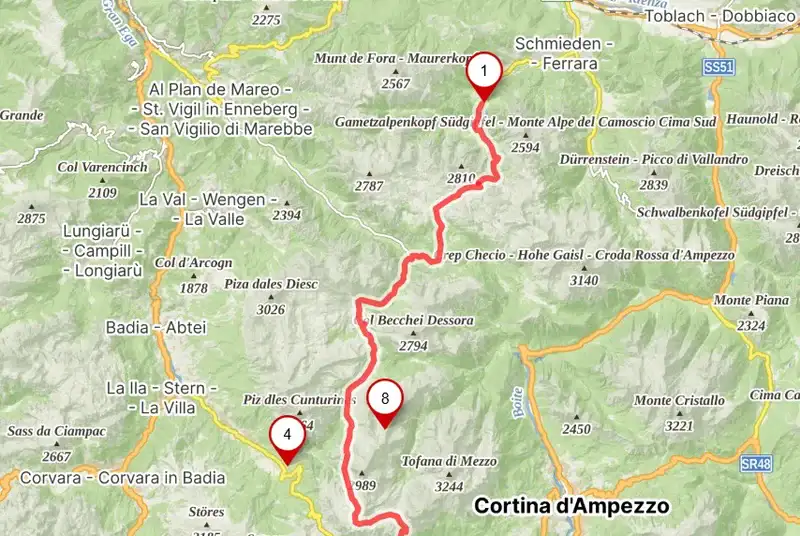
So, instead of descending to the deep Alta Badia valley and to Camping Sass Dlacia (marker 4), you might want to climb to this beautiful bivouac. After spending a night there, you can descend into Travenanzes valley, and then switch to the Alta Via 1 route again close to Lagazuoi area.
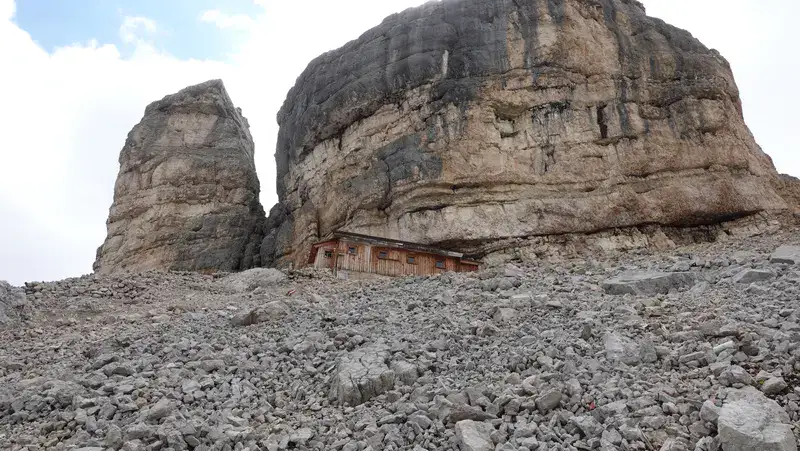
This may shorten the first stage a bit and make it easier, but there are no facilities here, this is just a bivouac.
But let’s see more. Below you can see the stage 3 area, and here I have added a few bivouacs that can be used to sleep legally and for free. There are no more bivouacs around, no one is available in the critical central stage 2 of the trail.
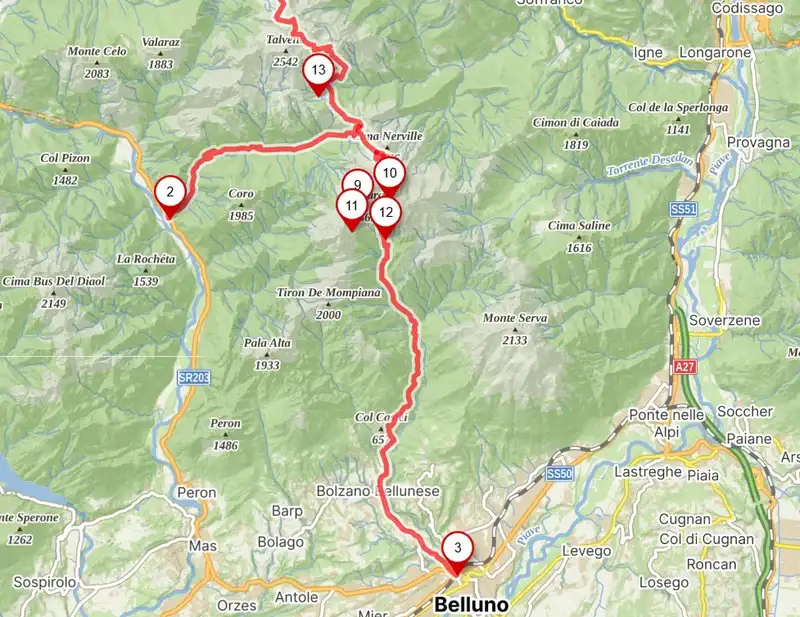
The added new markers show the following:
- Marker 9 is Bivacco Ugo dalla Bernardina.
- Marker 10 is Bivacco del Marmot.
- Marker 11 is Bivacco Sperti.
- Marker 12 is Bivacco Severino Lusatto.
- Marker 13 is Casera la Varetta.
Now, have a look at the complete map:
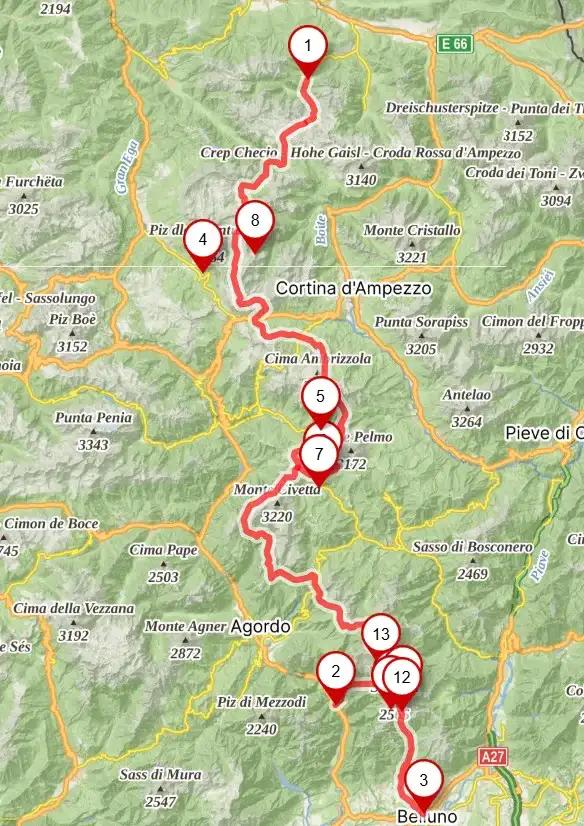
Remember what I mentioned about the length of the three stages? Now, you still have three very long parts between overnight places, although you can formally do the tour in four stages. Straight map lines between them are still around 15-20 kilometers or so, and in reality the length is twice that number.
Though the previous third stage is now divided in two stages. It is easier, you have less to walk from the camps 5,6,7 (whichever you choose), then you can sleep in any of the bivouacs, and finish the tour next day. This all would imply that you walk the trail in four days.
If you look at the map again, you can do the following: 1-8, 8-5, 5-13, 13-2 (or 13-3). You can add one too short day walk for 5-7, but there are still three stages that are far too long to walk in one day.
Tempted to camp wild?
I am sure you are. I have done it myself, but you might want to read about official rules regarding this, have a look in my another detailed text.
If you do camp wild, you might get in trouble, just saying.
Final thoughts
To wrap it up, no, you can’t legally walk the full Alta Via 1 route by camping only in official campgrounds. The campsites are too few, too far apart, and not positioned in a way that fits the daily stages of the AV1.
Even if you split the trail into three long sections to reach the few available camps, you are looking at many km per day, with serious elevation changes. That’s hard even without a heavy pack, and with a tent, sleeping gear, and food, it’s a grind.
Bivouacs do open up some more options. They are legal, free, and can help break up those long gaps. But they are basic, no food, no water, no services, so you still have to carry a lot. They also don’t fully solve the distance issue; you will still have extremely long days.
If you are thinking about wild camping, yes, it’s possible. Many do it. But it’s officially not allowed in most areas of the Dolomites. That means you are taking a risk. Sometimes nobody cares, sometimes they do. It’s up to you whether you want to go that route, but know the rules before you decide.
In the end, if you are set on hiking AV1 and want to camp, be prepared for compromises: extremely long days, more weight, fewer comforts, and potential legal gray areas. If you want an easier time, mix in with regular huts.
Note that we have an interactive map here in the site with all the campsites in the Dolomites. You might need it if you plan any of the 10 Alta Via routes that exist in the area.
Any questions or comments? Please use the comment area below.
Please join us at our Facebook group Dolomites Visitors Hub. Thank you for reading and have a nice day.
Leave a Reply